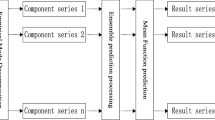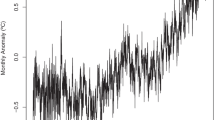Abstract
This paper proposes a new approach which we refer to as “segregated prediction” to predict climate time series which are nonstationary. This approach is based on the empirical mode decomposition method (EMD), which can decompose a time signal into a finite and usually small number of basic oscillatory components. To test the capabilities of this approach, some prediction experiments are carried out for several climate time series. The experimental results show that this approach can decompose the nonstationarity of the climate time series and segregate nonlinear interactions between the different mode components, which thereby is able to improve prediction accuracy of these original climate time series.
Similar content being viewed by others
References
Casdagli, M. C., 1997: Recurrence plots revisited. Physica D, 108, 12–44.
Coughlin, K. T., and K. K. Tung, 2004: 11-year solar cycle in the stratosphere extracted by the empirical mode decomposition method. Adv. Space Res., 34, 323–329.
Eckmann, J. P., S. O. Kamphorst, and D. Ruelle, 1987: Recurrence plots of dynamical systems. Europhys Letter, 4, 973–977.
Grassberger, P., and I. Procaccia, 1983: Measuring the strangeness of strange attractors. Physica D, 9, 189–208.
Grassberger, P., and I. Procaccia, 1984: Dimensions and the entropies of the strange attractors from a fluctuating dynamics approach. Physica D, 13, 34–54.
Hegger, R., H. Kantz, L. Matassini, and T. Schreiber, 2000: Coping with nonstationarity by overembedding. Phys. Rev. Lett., 84, 4092–4095.
Huang, N. E., and Coauthors, 1998: The empirical mode decomposition and Hilbert spectrum for nonlinear and nonstationary time series analysis. Proc. Roy. Soc. Londen (A), 454, 903–995.
Rilling, G., P. Flandlin, and P. Goncalves, 2003: On empirical mode decomposition and its algorithms. IEEE-EURASIP Workshop on Nonlinear Signal and Image Processing NSIP-03, Grado (I), 5pp.
Takens, F., 1981: Detecting Strange Attractors in Turbulence, Lecture Notes in Mathematics. Vol. 898, D. Rand and L.-S Young, Eds., Springer, 366–381.
Trenberth, K. E., 1990: Recent observed interdecadal climate changes in the northern hemisphere. Bull. Aerm. Meteor. Soc., 7, 988–993.
Tsonis, A. A., 1996: Widespread increases in low-frequency variability of precipitation over the past century. Nature, 382, 700–702.
Wan, S., G. Feng, G. Zhou, B. Wan, M. Qin, and X. Xu, 2005: Extracting useful information from the observations for the prediction based on EMD method. Acta Meteorologica Sinica, 63, 516–525.
Wang, G. and P. Yang, 2005: A compound reconstructed prediction model for nonstationary climate process. International Journal of Climatology, 25, 1265–1277.
Yang, P., 1991: On the Chaotic Behavior and Predictability of the Real Atmosphere. Adv. Atmos. Sci., 8, 407–420.
Yang, P., and X. Zhou, 2005: On nonstationary behaviors and prediction theory of climate systems. Acta Meteorologica Sinica, 63, 556–570. (in Chinese)
Yang, P., J. Bian, G. Wang, and X. Zhou, 2003: Hierarchies and nonstationarity in climate systems. Chinese Science Bulletin, 48, 2148–2154.
Yu, D., W. Lu, and R. Harrison, 1998: Space time-index plots for probing dynamical nonstationarity. Phys. Lett. (A), 250, 323–327.
Zeng, X., R. A. Pielke, and R. Eykholt, 1992: Estimating the fractal dimension and the predictability of the atmosphere. J. Atmos. Sci., 49, 649–659.
Author information
Authors and Affiliations
Corresponding author
Rights and permissions
About this article
Cite this article
Yang, P., Wang, G., Bian, J. et al. The prediction of non-stationary climate series based on empirical mode decomposition. Adv. Atmos. Sci. 27, 845–854 (2010). https://doi.org/10.1007/s00376-009-9128-x
Received:
Revised:
Published:
Issue Date:
DOI: https://doi.org/10.1007/s00376-009-9128-x




